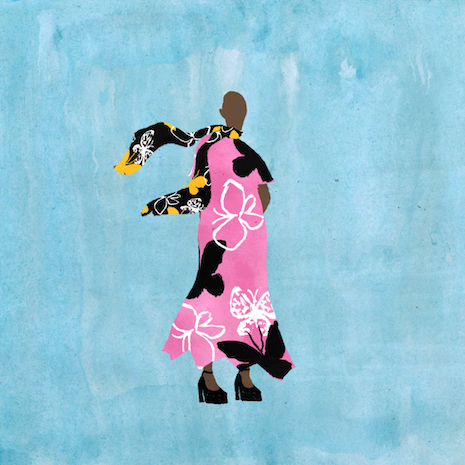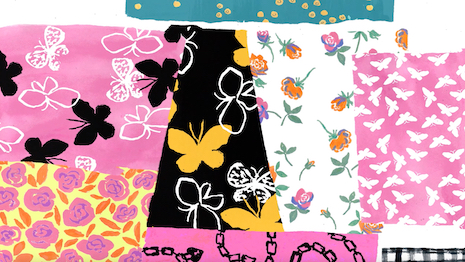Italian fashion label Valentino is redirecting miles of deadstock fabric via a strategic sustainability project and accompanying partnership.
An undertaking that began in September 2021 has now blossomed into a detailed upcycling operation. Executed alongside French reseller Tissu Market, "Valentino Sleeping Stock" redirects dormant textiles to young students, costume designers and other professionals interested in reworking the brand's discarded fabrics, giving old textiles new life.
“A deep, personal and shared conviction lies at the origins of this initiative: the importance of upcycling as a driving force towards the change we aim to establish in the fashion industry,” said Frank Lellouche, founder of Tissu Market, in a statement.
“The pursuit of excellence, inclusivity and commitment through the creative process are some of the chore values that we share and will guide the next steps of this unique partnership.”
Deadstock dealings
Simply put, “Valentino Sleeping Stock” is a program that takes extra fabric hailing from the production of the brand’s haute couture and ready-to-wear men’s and women’s collections and submits them to its resale partner for relisting and redistribution.
The luxury brand’s deadstock fabric will find new homes at the hands of Tissu Market’s clientele spanning the opera, theatre, cinema and fashion design realms, reaching costume designers, young students and other professionals willing to make responsible use of the resources.
 “Valentino Sleeping Stock” campaign graphics. Image courtesy of Valentino
“Valentino Sleeping Stock” campaign graphics. Image courtesy of Valentino
Maison Valentino’s Chiffons, taffetà, dévoré satins, crêpes de chines with floral prints, silk georgettes and guipure lace and more are up for grabs, going from archive to creative audiences, versus landfills.
Thus far, the partners say they have saved about 22,000 meters, or 72,100 feet of fabric, and have prevented potential emissions in the process, having avoided about 265t of the CO2e — this is the amount of carbon dioxide that 12 acres of trees are typically able to remove from the atmosphere — which would be generated from new production.
An equivalent of 442 Olympic swimming pools full of water has been saved in holding off from new production.
Any proceeds garnered from sales of the archival textiles are to be donated to Valentino’s six-month training program Bottega dell'Arte.
Established in 2015, the effort aims to train professionals for the Atelier, ensuring the presentation of what the brand has dubbed the Maison’s “sartorial savoir-faire” for many generations to come.
#ValentinoForAChange
With “Valentino Sleeping Stock,” the brand fully embraces its house code surrounding resignification — the challenge to find new meaning — runs concurrently with the creation of timeless items and collections.
Valentino’s overarching ethics and sustainability structure prioritizes people and the planet — its latest initiative aids these two pillars, by introducing a third: the creative and responsible reuse of products.
The fashion label's activation with South African fashion brand Thebe Magugu provides a solid example of this unimaginative ethos.
In a campaign film, “2 Designers Transform Each Other’s Work,” Valentino's creative director Pierpaolo Piccioli and designer Thebe Magugu swap visions, each reworking a garment from the other's label.
Mr. Piccioli and Mr. Magugu join Vogue for a designer swap
The couture undertaking of grand proportion represents a melding of the minds, showcasing the best luxury can offer when two creatives come together in the name of upcycling.
The collaborative collection was executed in partnership with Vogue (see story).
For a look back on the ready-to-wear front, the brand debuted a compelling sustainability initiative, Open For A Change, at the top of this year.
A short film showcasing sustainably sourced sneakers, part of the label’s spring/summer 2022 collection and the first iteration of the new project. Open for A Change, complete with a digitally printed green logo with arrows indicating circularity, is aiming to unite the brand’s creativity and ethos with its environmental goals.
Sustainability is reflected in every aspect of the effort. With quick, artsy shots, the sneaker propels into the clouds, then is put in environment-centric packaging, made of recycled cotton and paper which is sourced from sustainably-managed forests (see story).
{"ct":"s6+DuQwTYdkf4SZ4WG\/3oWRVPfxMs4RtpMusL0fRQvq6pqfubAMoxYkLJyLYVQtDC39CaY3SSjAAlD84u52BP7yUIfYspOKDhQewAjLJgJ5Vpcww+gokdpErqJKV91O06sCrIQlJzoyoSxLqgcGdgByLtJx62EP+yaNyZWcKm67SsryWBb3rZ2sCEchp5ITVUUYljFhTZIOkXET1OqpWDA9LqtLnNbrz8dxdjdqGNALinEP7dlG5GlS351f0pwvS3OkvhkenLwtJNFgl2bcbSRzNj+3DBLPqAHZnvnFtfwQ90SG8IilIF64yOlKidiD2lhKtZnlEaQ5ghP6w8+tO5wYUJFIF3gItVAUIrkpdVJNvVj07rWax9\/mBeqh3nRcP4Jm+yfrFcvGBYCXFXVNVi55ap9\/WxvlJwBjU5Av\/DwW1M0kJ6KbiBsiwrghh\/lhjbsaJNi5fQ19nyXqBqaOIRAA0I+BRyL+OEY4kOwerYz0rDobBTHEa1cBnUn73IyfM4s30oOHmdWvX4nb8W\/QFwDHJCxByT4wZsAzP+xRHq9WYdjG3ijnW3F7DgGC9ERDsfZBjGKUeJmWiLybKV4B2+spVzWZWJelBFOz3W7eORQ6qR0LFvNf37xx1i8EAtraRijTI14RZ1uXrWE\/Xa1fZw9+QaQ9Ws+TYoWpqaT51Pn60rLtCo\/8BJW9qcz5Yhd1Moc36IZyRq5C0XJQI2RiAH9p92HHg27eZ8Jx+3ohnIRryGLy\/ZVUt\/juBPUVNqYN0HuPTT9s32mK8fPSe54rZgr8bEkTFo6DKwc3hIRYlFUoPRJO6ecRXZaKwmEreni48nwbtKRS9SjbXqf9wgr1uTcZ3XlCYdNPbBsL\/t9AOg84hRmVY6\/l\/3YXOzFvKu7wLA3A4GaYHcXPDGkHjBtZevWhkyEgec2eP6xgwUWRLSQsiTSDm6s+sEUscwa7N2kshgRvcw9FtZwFyWqYA2s96HTTLi2bgzHc0QdilIB4X6IeSGfQTDe8uW72V4edXlvvpBTs6YUd+dQvTjPbHOcePMex2w9iTOnmg6h5+gwk0kHhFzEZp0pIoJxpOHfIpSb+s\/Hpnnw8ayWai5k\/XYuUY9sgapohipq+Ydvii2Xt3l\/GZVuu5z8rKP\/wvmMTrxlTmtpoJe+8HsVQo1R9tCovkuMEvNIAS4m1WUv9JT9IY3MTLnSY4GK7rPRG\/iAk4r05aCfDU2f3iJ962Ac4Ptw6uBW3o2lTqkyMMMzDufWbtWftvuW24JJjH\/MjCVKUeIy4C+RUceWUQtbupe8IAPecbVeZoLRT\/Zs\/HKehLIOPYIGf8yNuA5sPpG5KMR2QRGf8U0glTQskwhgL\/YJzLmlCJVvCsc8Czd1JxZre9y2JZ\/XGm3bZFP3MY4n79mtli2HSdW66GMps8ayYfTnMbWvbx+DKL2AAIpMYkw9I3xolsJa3ZiENkdykQJMT\/N+h3sc5lxwX\/ZgDE13EW1dfFNzDG7FXADQWDuJzdfZ9pIueBLBt7sbbFt+cPsqGkaLaYgMcucBywtYh320AZxv9lbsaOpd7rLL7IBIwdHoCzMs9QhH7CtxJ2DM9JRZfRiCnMdolXvZ8MOVbn3X1LIyu9GhMd2scvAMAgmvw9fBAOh3VZQNwj\/16NmPa\/H56RsTtyT48OYL5yzIUwlGpbDg9KVl224wJg1T8UT\/pC1uraJmH7hZ3ZRjbWSiD0Gk3uy81VAuOk4KOotyn28xQmn5+27tCdtA9SZ7Jt6T3yOE5ydruqy4zAiW3CfCF9YnwG\/YYYvhUJAj33Sx4TCzGZBKykbIuiE7F6OPT41swDt3q5sEEtAEvuEsreRGU6Ig8KbHUTNir9A0BS4p2XdGXeiKh1CO0ewzaGHDwPfhVj\/kNfDKA+47F8N49yhORG6060sHjIO+KNr7FZDKEy4URF9lKc0yR1+zA+2nuMcJPGlobIsjMr5UnO68huGfHCEBi4jpgI9cMWgCqvSn\/+zO9kPRW08wlUQq28kfrwlnrzOYLShw+Jul++MxYAj5qjhmBmveaPJClSpeVWWULHxMHjk6aRPBPOZox047EzqckDSoXgJESrRFFI\/h19zEsTB4hfElPVhbLek8v2da7JfxeGy0r+3mzHZtdrmpHFg3sInOTSeQN2pd73Dei3X6XHAuaQdEmkohCC0rPcc4CcCbQ4NWFP05tAHznpWRVBLuL5ItvMS3dAMVMRSukDnTz3R2ZUdogp3S8oZJkI8WijqbltKyBCmoMEBlueayK7MI8xQCYLOp4NS0Bf03LtYbz7gFZY+E0bmA4rPAAb9TbVKtpwkrLbgSL4iyOOpcqtEsonCV9htJV6ZvTdGMjskb8NKQsvOvVC2FKUYhMyrzbBKlug+OPEMMDWEPnmuHZBRTFlzVbOc1uuqXxsDrI8KtPaGY8Wy4PA2JvSRG6Fcu+2Oy\/PPQJQSA1kGsp6DOhwonWi4HYMWdpqGSPfqxIpUyD+dnNkQXhCZgmzXsFNgfiN6lo+GhIULQDIi2yVQJJp361D5rfA\/0BSXro6f6n1lK+A+2Q8Tj6xf2uV4stcKMRW+Rva+KkByZuQvhILhGAA05zUMnS+b+3r+SSBo5T+iaiROFhqjENiRzNdej+DzERuVeVfKHw2LaukC71vSdMHLuZUSKxovrpITXN91FVMEE1j3GgmfFzX\/xmnOSsGrDTro4NeHgpmWKnrg+AjeeRbuDpvSx91c1pHoRWNMaNN5ce+bR1SkzAUO7W1epVq6yM\/87V0JPoGx1GPwJ1xQFPoR+1Ha+vsA5TOMUlW6N1jrL7pUH50hUQeGus30fi8B3RtU5lwSs7kPpEUPi4EikDhZYWmh9Bhwn7fOdfACI8qdKTBVvJR1ZPslaNOca+IhdoHxi2iUCAP9QSxmFPpYYGjzfLoLgGeXkLnF8GoQQKQLR7eXaVspQzLz4EhGg6YtYNdh5KCgP98\/u0YInOfdOb3LAo12fGVvqXNjggGH+ojLqlZ90fVPN\/MMvrOhBRHo\/NNqjCqU2ZUNJslScgD78tMX\/xfkPBkmxsXIBunt2BCxbD1291MNlAgnqTVfM9hZ4PsOPUKQloElW8xXlgM4wYDi2OTQyV\/vvDw3TeRJYjsaM+5H0nzsv9L9\/P7TuD8n5eEB5td8L8oQhF3Lf+r9C7STX8fgfapLD4Y5h3q4M6OPZP8tJ1zgMm5DPqFyfag13bVF\/g8xKcqucspki6b0OI3seRaMXg\/2z7x31bT9c1wXdhOupyqPlbdw5Xj3BdLnJ771YkYQ1wPEcv89zc2wyIaS8Io8U4libWt4pt0u2KB6bXuN4WMRLvepa+ET3h09SyQZVBI2\/AM2sTZ97gqlNyGeDH3WojVIX37G\/QRCq24F0lUEIvhfdRIFKBtS7mXapHtgoxGZYx4+NbXIzfVIVSigUs5GdcMC3mmaY8+2WcaoGJx5UW4Zr0LwiZ1\/qJFsp9VeXKLAVPEA6MOdXCmFf93KF+\/XUDzR8t5N7jxL0sQzHhSLlcismAu\/DmzqhJH7\/dWyhWjgHKJVh4NV4J2l4+qEv0KxNQRARZ8NlUuy6fa+CHIBS+5tgXhenEdEXZ+s+5o41O4pvD11fMRt6pEKC5KgXa8XmQ5B2YeSTkTOs5YUdAuib4Lz4szZOjnfLEaCsD8Y+OwsOOnq647PBenFwEO8JkEJhpVsXM6A3GE9V1ggydVOa3uUtvWRtueedxPlLbFrPqXdqM\/HhKT2wEQIZ9x6B2NKD4YUtVbm2wLyvHP9iUIJ6vmnGOwf\/NcK1h+vNmul5Fk6ve\/8yvQeJjwfhHMUEZn7TLUqGiCb5cpgRsjGPEJwZPgNrIOtWY3DpUrsnDl+HQb2VWdAJl6Ys1\/XYIHxOMoj7lnbsWmntCeOMYfBcJvFOcEJReAXN1l+AoU\/KjDp8fvnuiunBhRRL6XrY7Exd6MM6xxbNWq4CCaOH6npCT0YZ8kSBmZPzJ4Dm8WlL0WnrGx6FDKF+Em3z6FA8i6OJ26zdYP0EKG6oBOqN7nROX2zlcKxt6QuBIiyjZLjDtXGyVCeuqzPUoKkiMcunRl79lakEAd3UvRpEljMe8+\/hEICRqS9Q9Tl001xyzsMqSVOzOZW4I9AITYwil9v6zAqf4fgjIElUkAerq1V8NVwddmsymiPbRJQj6LkyEywX6Igq0coVitNYvra1FKom9u8mk4sGixKK2NfQwQHJGly7vb8obdfYW0wbfEL3dEPID\/\/bJroiiTb7dGEKSAb7SY3uGSqxHEdDXAXhDm8KOKf0h5oGjwOZnS+s2Fu7cpCOEAjpc261lfO1NH3s1sVyOcced3j6GNP0VUczGDg22l\/5hHACP5zq59Pbn\/XZLL8XZVhIqhxSeGfoumSS6wLBoasNpUEsJ9VGRP5LZATijbvAaMGlBFbPrCNymclW6s1TdR452KDvwm5bSgkUenRvsdJ9+442TTqRiMNYdRurFINRIHOnPZTliqCxLROdK9zUypyrA8vZtWWec7e+UyPAefwqiV0qD69Lj7lC9oFYcRcNGzkFE4QkkA4RhxznCDA6oLrFyenP7xes5k0K7y4kACKIusoEby6IuP0dH\/pvco8Td8bC0ZJQvcBLRLEP19YTLN0J9OpzuPxISWJqVbsv98iZgnREZ1JVeD2mB3quseYArJdMOQc3wroz3VGV+3lCDq25zAHF5rV052ZpUUcqZNYO5O7KCbHlEDAO2nuFX1kaojHLMc+5PyuWltm7ONlVvVphg+EJbQ8edHK3dvBzsDs6+oTG73\/eg5QUXqIdm8eZtx+2KQ4YyssJK+v\/ZXMj4beNzM2fBnK5QEr88qmY5M7iG9Qu92kvoDW7vSJTcNAJpe\/NCen2jVqhmunn7cjQgKAV9J32gfSDYvJUZzN\/I8VSulAIL9U9qxvrGG9vGo2\/CLgi\/0o2wU7Ti\/8riOViWOfXF4rs5WDB\/viDQjN9+UZnC6fcpWZ\/wLUUCkN7sYwOj2t9Bmvu4j7EcFRI1ej\/+qBL7THqwfT9NP84fVOu97mSZTdqi69nR\/p9Rwq8THhepKjpedGdEujUQsdVd5k0bcOUiudBmQbrLk+nikDkGun5+3uKNXWWqJXT\/c3U7Qq9EcSQUyNhCPEj8wthtWqalJxVVi4auWVkw12zUVh3AH8Mz1STdpdmczfh8MeTJmLq3RhaTjVXYtDp4CgH8JcJxGNSw0HV7TsSOsWpc9PWDiyE8d7jHizzU4OmGYRrCQYLTUertHZuyHjA6b\/25peuHMuNHw9hE1\/Q2w1zNqcsRdfDGDkZZUD0EHo7Zlni3TVEnL\/Q0pa+qJjBv1rAqi8tBDHjvapz+1kEN61siLoVVYBNa91GinaFE274eoATLcBFQAhI9EtZxdZF2letMKHmXrgqpfobyfokTryYpU61buAhdY5XTG6cpN1QVxjaICxCAIXzs639F\/uPqIFKmcHVi\/76aWQ0oskhSCFhpeKhoXN5nNIhjLrPKWmSlhuLRY\/x2VJJsned3abbkSLEovDVJok6FVyL0vwfG3cqb\/Os3uYRcTpJMdAq9dWoRos12Czqzgi6aHNxD2VHUo55pCUtUK8pneOu40IvoNKpRqfHZaYU4KpJHo1tQ9wmsg9N5SGiMaTghLupRjOIU8Kdc77hB2qU2rU4rM1Br839yA\/SAzBIsrKrnfdRJ9akQHM\/13bSCvddsExHUfH0PxJGWPIj0JjENeJqzp5YVd5uWSVGEoQDVKlL8r56UNHHx7jeAPXe4Pk5gxeu9umVURXTTcIN5rmNasLyCB14m473BHhyGB+slCuu+QvkLUu22hEsABXRzo69pZ+RQlg\/mztoYXG8aUvHAs+CYr8sYQAXfRcsYEWGY21knKIDY+k+qREp5VhLSRBaAa4mp0s\/nypf\/whvTVoRh7DOfawNLRrNJHRK2B3VT\/PKInjx0ug+qrMJ+1KZkhnpg38mBpXbITZmdh2xRNRW3euy1kSqasfGNdSVNtr4ouYmjJ\/gVrryJg3ZMYqbGLcdt1NUvw7iMnflgNf4RP2vsiapMMoqOKo3KhDwpHIGls1aTbM1eMWELJKfg7h0923fTY9vRjI2A6Vhyu1qOAHZuZglBWsRNouUdhStQARP2dUyy4gCN0RZzJLDQn\/1jtpP3dcQtWCqlH4aZe2BIumCzW2L6ZxNNIJCYzzhxsa0VlfnEYdKxgPsmUEdQxJKDjt61UZx+uTnG5E0DHz3VbsDsKlpPdOwHb9M72hD2FxS7cc7GwwoMh\/Mr6LHElqrCXxnODF2+45RDulCabHbrnJiXFlxiKLKXYw6FvLTjh+CfNBQ+c\/Z4s2NCmEB+zuruvGSA9BkfiSoKQk1paQ8X+ubCXrPZocuWYoIu7Wpp3Or1hhMiVCT80Hu1FGGDWwRYk6K0yaPTTx3YDN9gjbJyeYDRzSn1Vy3so7nGOdE5EKqT5IglUQkhtUO18tF2Nel1bPQ1oWYWcRUKgufbh+YgmSbRO24ukStE28QaPfZEudXh42pWRhM5FvhBz1RvZo1c1otWwqJNBVB+z7jJ84KYJg92eaDNKHe7Yl4l13J2Eo83T1sDgmpGEnPZ+9\/Y9\/uF5ryZZk75sWGOsZTvZfGjwK3zQy1bKy5zIh8DSM5hCcvcSiQhv9x6iHapGL7SddSa5Ga\/ItuaON2RkkXJUcc4n6AjG6xzPzPg+ayk42EOMKeuyNdz+91CwT6O7vtg3t26hhoKIr0X3tJI5mmGy0ywI+r2eEPj5U07ugt4fggCr1loILiCsZDPF335uVHaeDRC+VtUHluDl6pyOTK+Ep4aAtyNp+tl7GgVHWK\/c0egTDQxqGTSGQU4S8DL4Bd5OWL8FbxRv1cGBxEPVOMdJUivbvBuPdMAJfw8HiKcJASVQHXzBYuMDnQEib\/v8x5aKMffyHu7FJ\/bGekyFDUlpGvlhL2\/Gy2YrzFekcdQhB\/E0Y0xKEfAYZyrjU5oVjkFmyJaC9S5z9QaHpZ\/55LlpJd1vDtnkR6aAXMT3IiM7ux4leS94KtDYOsTbeHtbjPEubRWGPwA0wSaKB86sEq5\/JoCvFNMAt89Q8X\/zv\/Pn\/OcN70aQCUddrEOEvtablVfgp2cnMF9cMf2yFd2EKCYHdI2FBsm5+Xqc\/0bL2GVeprjafq\/ZiSgDwM6mt9\/tEDcStW5YqAIOOXIMC6c3MpLn4oywP1rmKFANzmkPHLsaMIBliMDIb1QpfVz6+056zMtM4G1VLSISeF+RngxaKzP3052xcggmXuP37BgS42oB2w4nsARaI1I\/z4Z2UhbBXzyrHZV45Z+266aRipGsx68S7tO80sZ0Vf6o5bpfmlMo6ClQZuHChOx5iAOHHkBLizq\/nUpaWN2kOAX\/J5ydhAtX\/TFCRx9sonT4GZAFqaISG2PUrLoYjQTatng6XdgIIVWFV8PlsmQ+BJIYWWxLkrmngE4sj\/7+g26Y2A2sbwoFA\/fYqRRn\/7nR63jUMJHaRq8qd9SdD\/TbIWASG62txA9Dfa\/YwlAzCEKKnmnzQvkxmgfIZr9zth32I7We6rtwK\/qrAq+y8Hp2wHW48H3I4IMYspfLKRn1nLcA5QXqof9L65ed23JWGNRcp22TXuZofFLK0ooeYSZWOqqolCZVY3K4aqebu3mb58fLBtMMNub+cUekVJ7Y8otpVLpMdnD3qxfJ6aNkOdrUg5D59jfzGp4CAiwq0dWWKNB6rXignRMD\/JaxdNYvvu8+skbNUoS1SVRlgb4UIY8xMkoS4MxEru4s9NiDKg1AhtQ5Zh0NnwGVy1CswZvxQGcgdKNVd5sAUErfQFAYlArW6mNNK3y4qfjDYr29PxSd9URXxlLwBHAJaJiSuGkQDz1chHu2x5CUuyhnVQWHMQJ90lKVrxA2vzKyDNzFt0xUuL2YJhMcXAueOPp\/2iCgGfI1g5i\/vBxfW9q1ZMUMiskA3smhATNao9BD5FuY\/XrEWCtDgohmpjaC9YUyAVg5AHK8yj6T4FYcVLQp2Jz96N\/C25XdUEaTeVVKEACUavXRE5GCpIGflw==","iv":"aa5c62f6d6a59e8c7497615595fb0ef0","s":"9795b73372a7c287"}

 Costume designers, students and other creatives are breathing life into Valentino’s “dormant” fabric. Image courtesy of Valentino
Costume designers, students and other creatives are breathing life into Valentino’s “dormant” fabric. Image courtesy of Valentino  “Valentino Sleeping Stock” campaign graphics. Image courtesy of Valentino
“Valentino Sleeping Stock” campaign graphics. Image courtesy of Valentino